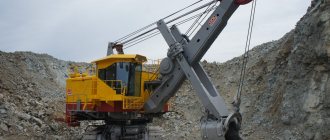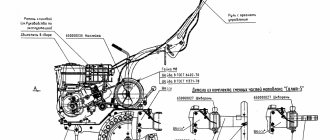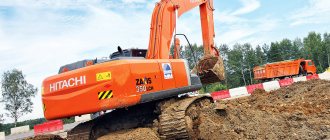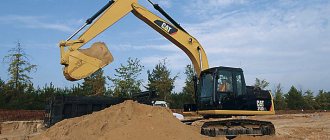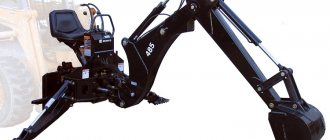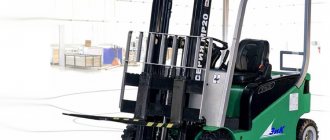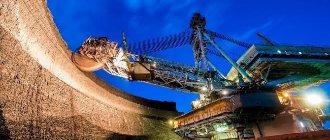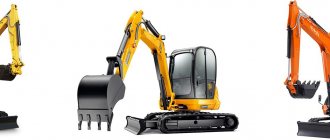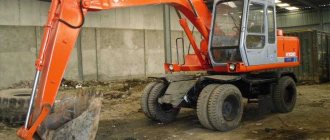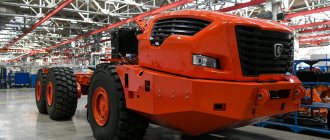Backhoe loaders have firmly established themselves on Russian construction sites. Their mobility and versatility make it possible to abandon most specialized equipment - wheeled excavators, light front loaders. The machines can rightfully be considered the most adapted to urban operating conditions; the speed of movement and small dimensions of backhoe loaders allow them to move on public roads and work in very cramped conditions. Today, almost every manufacturer of construction equipment has machines of this type in its line. We have collected information about all the most famous manufacturers of backhoe loaders and presented our readers with a choice of more than 50 models produced by domestic and foreign manufacturers.
New Izhora cars
In mid-October in St. Petersburg, at the round table “Mining equipment of OMZ Corporation - an effective solution for your business,” the Izhora Plant (United Machine-Building Plants - OMZ, Uralmash-Izhora Group) presented a new line of mining excavators, currently only planned for production. At mining enterprises in the CIS countries and abroad, specialists are well acquainted with the plant’s products.
We are talking primarily about ECG-8I and modifications, as well as ECG-12.5. Since the late 1980s, the plant has supplied a large number of EKG-10 and EKG-15 and their modifications, and the production of new machines was a logical consequence of the modernization of outdated models. The main distinctive features of Izhora mechanical shovels were and remain a two-section articulated boom, a torsion-resistant round handle, and a rope pressure. For a long period of time, the Izhora plant adhered to the idea of producing two basic models of excavators and their modifications with extended working equipment. The new line already includes three basic models, and each can be made with different options for working equipment, i.e. according to the classic Izhora plant design with a rope pressure and an articulated two-section boom, as well as with a rack and pinion pressure with a double-beam handle and a solid boom. It should be noted that this concept is quite bold.
"Tver excavator"
The Russian market leader produced 1,290 wheeled excavators in the first half of the year alone. Its traditional products - wheeled excavators of the 3rd size group will remain the main point of the production program. Market priorities will also remain - budgetary organizations, road and low-rise construction, i.e. the lower and middle price segment. The main advantages of domestic products, besides price, are a large repair base, availability of most spare parts (unfortunately, this cannot be said about the full range), familiarity with the design and, probably, habit.
The plant mass-produces four basic models - EK-8 (weight 8.8 tons), EK-12 (13 tons), EK-14 (14 tons) and EK-18 (weight 18 tons) and is constantly working on improving the design, mainly Thus, by introducing imported components into the range and thereby expanding the offer due to the variety of configurations. So, when purchasing an EK-12, you can choose between D-243 and Perkins engines, when purchasing UK-14 and EK-18, you can choose between D-245 and Perkins. For the EK-8, only Perkins is available, since no domestic engine, in terms of dimensions and characteristics, fits into a compact car. In addition to engines, there is a choice of domestic or imported hydraulic equipment.
Basic models are regularly upgraded. Thus, at the STT'2008 exhibition, the plant showed the modernized EK-14-60. Fundamental changes have been made to the design of the working equipment: an extended main handle with a bucket of the same capacity allows you to increase the digging depth to 5.06 m with the same productivity. A Perkins engine was installed, providing increased engine life, the hood system was improved, and new layout solutions were introduced for installing fuel and hydraulic tanks for better access during maintenance.
The second new product of STT is more significant - it is a new, 20-ton model EK-20, i.e. the plant decided to seriously expand its offer. It is equipped with a YaMZ-236G5 engine in combination with Bosch Rexroth hydraulic equipment and ZF transmission units. Both bridges have double-pitch tires. Together with the EK-20, the premiere of a new unified cockpit took place. The interior was improved with tinted rear and side windows and spherical mirrors. Control has become more convenient, noise and vibration insulation, and cabin ventilation have been improved. A new, more informative instrument panel has been used.
What's on the market?
If we compare the products of our main competitors and world industry leaders Bucyrus and P&H, we can note the following. Bucyrus also offers mechanical shovels in both cable and rack and pinion models. This separation of designs was largely a consequence of the merger of Marion and Bucyrus. However, the latter produces models without variation in execution.
Light models are produced with rack-and-pinion pressure, heavy ones - with rope and crank-lever pressure. P&H only produces mechanical shovels with rack and pinion pressure. Of course, the issue of installing various working equipment on the base model can be classified as a completely solvable design problem. The fact is that at the mining enterprises themselves there are supporters of each type of working equipment.
Uralmash, also part of OMZ, continues to produce the EKG-5A, which is still in great demand, and these machines, along with the EKG-4.6B and EKG-8I, make up the bulk of excavator equipment in the post-Soviet space. The plant also offers a relatively new promising model EKG-12 (14) with rack-and-pinion pressure and is ready to supply the already well-known EKG-20A. The rigid double-beam handle of Ural excavators is well suited for the development of heavy rock faces with large pieces of blasted rock mass. Various modifications are possible: the use of built-in pneumatic shock teeth of the bucket, the installation of extended working equipment, the installation of a primary diesel engine.
Previously, Uralmash and Izhora plant did not overlap their model ranges in terms of standard sizes. It is not yet known how the management of OMZ will organize the joint work of both plants in the future. It is quite possible that factories will begin to compete fiercely in the market in the near future.
The names of the models of excavators of the new line of the Izhora plant are linked to the carrying capacity of BelAZ dump trucks (136 t, 220 and 320 t), in combination with which these excavators can work most efficiently, i.e. EKG-136 (bucket 18...20 m3), EKG- 220 (bucket 30...35 m3), EKG-320 (bucket 40...45 m3). The future line does not include machines with standard sizes of 10...12 m3, which could result in the loss of a fairly significant market segment for the plant.
It is not yet possible to evaluate the design innovations of these machines; much is still at the development stage. It is quite possible that factories are using a number of innovative solutions, including electric drives. Only a buyer could be found.
Well, what can Uralmashplant and Izhora plant offer today as a replacement for the huge number of worn out and outdated EKG-4.6B, EKG-5A? As you can see, very little. This is still the same Ural “old” EKG-5A. And if the Izhora plant switches to the production of a new line of heavy machines, then only one Ural EKG-12 will replace the EKG-8I and EKG-10. But this is all among mechanical shovels. Nowadays, hydraulic technology cannot be ignored.
"Exmash"
The young Tver enterprise took a different path, developing and producing road construction equipment at the level of the best world standards, i.e., it aimed at the upper price segment. However, the product is niche and the circulation is small. The company uses imported components. The debut machine of 2006 was the E130W wheeled excavator with a power of 72 kW and a weight of 13.1 tons. In 2007, another E160W LCE wheeled excavator weighing 16 tons was added to it. Both machines are distinguished by their design, especially the low profile of the engine compartment, which gives not only a modern , an attractive appearance, but also providing good visibility to the right and rear. A wide range of imported units was used - Deutz engines, Bosch Rexroth hydraulic drives, ZF transmission units. The main metal structures - chassis, turntable, working equipment, cabin - are of original design. The digging depth of the E130W is 4960 mm, the digging radius is 8470 mm, for the E160W LCE excavator it is 5960 and 8910 mm, respectively. The E160W LCE is also offered with a shortened handle for working on heavy soils or for mass work.
Mechanical or hydraulic?
Despite significant progress in the creation of powerful hydraulic excavators, the share of powerful mechanical shovels with buckets with a capacity of 10...15 m3 in mining operations is still quite high. Moreover, in this class, powerful mechanical shovels successfully compete with hydraulic excavators. There are several reasons for this. In general, the mining industry is quite conservative, and the introduction of new equipment occurs quickly only in the case of a significant increase in the efficiency of mining operations. A mechanical shovel is still a more reliable and durable machine; it is easier and cheaper to maintain. When applied to large long-term quarries with developed electrical networks, where the mining and geological situation does not require selective excavation at the level of one horizon, mechanical shovels are best suited. In turn, in difficult mining and geological conditions, a hydraulic excavator is more preferable as it is technologically more flexible. The weight of a hydraulic excavator is less, it can be equipped with both a “forward shovel” and a “reverse” one, it is endowed with greater specific power, is mobile, and allows for high-quality selective excavation.
Of course, the design of a mechanical shovel cannot be called progressive, and obsolete equipment simply has no other advantages over modern hydraulic technology, other than simplicity and reliability. Moreover, the constant improvement of the reliability of hydraulic units, the introduction of electronic systems for monitoring operating parameters, and a more affordable modular layout of equipment will make it possible to create machines comparable in reliability to mechanical shovels.
The cost of new machines is largely determined by the price of raw materials, that is, in our case, the price of ferrous and non-ferrous metals. And when a domestic mechanical shovel has a mass on average 40...60% higher than that of a hydraulic excavator with a basic bucket of the same capacity, hydraulics already have a price advantage. All this leads to a massive displacement of mechanical shovels in the class of quarry excavators with a basic bucket with a capacity of up to 10 m3, especially in opening quarries. Such rearmament is a completely natural process.
This trend is observed throughout the world, including throughout the former post-Soviet space.
Some mining enterprises have already abandoned the EKG-5A and EKG-8I and are successfully operating hydraulic excavators with an operating weight of up to 100...120 tons. The production of machines of this class has already been established by many well-known manufacturers, including at enterprises that have not previously produced heavy excavation equipment. Hydraulic excavator EG-110
| Parameter | "Straight shovel" | "Backhoe" |
| Bucket capacity, m3 | 4…7 | 3…6 |
| Digging radius, m | 9,9 | 15,1 |
| Digging height, m | 11,3 | 14,5 |
| Unloading height, m | 9,45 | 8,2 |
| Breakout force, kN | 640 | 640 |
| Speed on a dense horizontal road, km/h | 2,5 | 2,5 |
| Average specific ground pressure during movement, kPa | 178 | 178 |
| Pressure in the hydraulic system, MPa | 32 | 32 |
| Diesel unit power, kW | 450 | 450 |
| Climbability, degrees | ≤20 | ≤20 |
| Estimated cycle duration, s, when rotated by 90° | 25 | 25 |
| Excavator operating weight, t | 105 | 105 |
John Deere
The American manufacturer John Deere has been known in our country for a long time. The first deliveries of equipment to Russia occurred in the century before last. True, as in Soviet times, it was mainly agricultural machinery. For the last ten years, the company has been actively promoting construction equipment on the Russian market, including the John Deere E210 LC excavator. For our market, the machine is equipped with a PowerTech 4045H engine with 155 hp. The powertrain is Stage II compliant with auto idle to save fuel.
The open center hydraulic system is structurally integrated into the engine, which improves its performance. Two main hydraulic motors with a capacity of 224 liters per minute each create a pressure of 35,300 kPa. The hydraulic system has four power modes and three operating modes, allowing you to choose the optimal balance of performance and fuel efficiency.
Operator comfort is provided by a comfortable seat with mechanical or air suspension, a two-piece windshield that can be opened, and a large multilingual monitor to monitor machine status and performance.
Daily maintenance of the John Deere E210 LC hydraulic crawler excavator is performed from the ground level. Thanks to remote and grouped service control points, you can easily and quickly monitor the level of working fluids and lubricate the machine. Replacement of quick-change filters is also carried out from ground level.
Hydraulics!
In December last year, the Voronezh Excavator Plant, part of JSC Russo-Balt Tyazheks, presented the DGE-1200 hydraulic excavator with an operating weight of 116 tons, equipped with units from well-known companies. These are a Cummins KTTA-19-C700 diesel engine with a power of 684 hp, Rextron hydraulic motors and planetary gearboxes, components of the imported drive control system, etc. The excavator is equipped with a modern comfortable cabin with an air conditioning system. In the future, it is planned to create a line of excavators with buckets with a capacity of 4, 6, 10, 16, 22, 32 m3. This machine has already been discussed on the pages of many specialized magazines, including with specific wishes for improving the design, and therefore we will limit ourselves to presenting the main operational parameters of the DGE-1200.
Hydraulic excavator DGE-1200
| Parameter | "Straight shovel" | "Backhoe" |
| Operating weight, t3 | 116 | 116 |
| Bucket capacity, m3, with rock mass density over 2.5 t/m3 | 4 | 4 |
| The same, m3, with a rock mass density of 1.8…2.5 t/m3 | 6 | 6 |
| The same, m3, with a rock mass density of less than 1.8 t/m3 | 8 | 8 |
| Drive power, kW | 503 | 503 |
| Travel speed, km/h | 0…0,3 | 0…0,3 |
| Overcome slope, % | 80 | 80 |
| Traction force, kN | 628 | 628 |
| Average ground pressure, kPa, with a track width of 710 mm | 120 | 120 |
| The same, kPa, with a track width of 960 mm | 160 | 160 |
| Breakout force when digging by turning the handle, kN | – | 500 |
| Breakout force when digging by turning the bucket, kN | 670 | 450 |
| Feed force when digging by turning the handle and bucket, kN | 700 | – |
Taking into account the current situation in the mining industry, the Izhora plant, in turn, offers the EG-110 hydraulic excavator with a multi-support tractor-type crawler drive (D 355 Komatsu) and a rigid suspension of road wheels. The track rollers and track joints do not require lubrication throughout their entire service life. The YaMZ-850 diesel engine (YaSU-500V diesel unit with a power of 450 kW, rotation speed 1800 min-1) was used as the power plant; the pumping unit consists of four adjustable axial piston pumps and one auxiliary gear pump.
Hydraulic units and equipment are manufactured by Rexroth, the heat exchanger is manufactured by Hydac International, hydraulic cylinders are manufactured by Lyudinovo Aggregate Plant.
The three-row slewing bearing with external gear teeth is produced by “Avtokran” (Ivanovo). Automated lubrication system - German company Lincoln. The modern cabin is from the Kovrov Excavator Plant. All welded metal structures - frames, booms, handles, buckets - are produced at the plant itself and are made of 10HSND steel with vibration and heat treatment of prefabricated elements. The design of the bucket uses elements made of wear-resistant steel 110G13L and 20KhGSR, i.e. materials well known from the same ECG. Standard size ranges of mechanical shovels from major manufacturers
| Manufacturer, model | Bucket capacity, m3 |
| P&H Electric Shovels | |
| 1900AL | 7,6…19,1 |
| 2300XPC | 19,1…36,7 |
| 2800XPC | 25,2…53,5 |
| 4100C | 30,6…61,2 |
| 4100/LR (long equipment) | 25,2…53,5 |
| 5100XPB | 35,9…76,5 |
| Bucyrus | |
| 182 | 5,7…17,6 |
| 201 | 18,48…39,27 |
| 495 | 26,8…61,2 |
| 795 | 53,5…68,8 |
| Promising line of the Izhora plant | |
| ECG-136 | 18…20 |
| ECG-220 | 30…35 |
| ECG-320 | 40…55 |
| Uralmashplant, machines mastered for serial production | |
| ECG-5A | 4,6…6,3 |
| ECG-12 | 12…16 |
| ECG-20A | 16…25 |
The openness of the EG-110 rotary platform attracts attention, i.e. the casing covers only the power station and the main pumps. Still, it would be more appropriate for mountain conditions to completely cover the engine room with a body to facilitate maintenance and provide better protection of the equipment from external influences. For example, a rotating platform is equipped with 120-ton excavators Hitachi, Komatsu or Voronezh DGE-1200. It is also interesting why the decision was made to place both rotation gear motors on the EG-110 side by side. Since a double drive is used, it is better to place the gearmotors in a symmetrical pattern and at a distance from one another, so as not to once again concentrate the load on the metal structures of the turntable. However, all these comments can be attributed to the usual “growing problems” that accompany the introduction of any new technology.
Both factories have chosen similar tactics for the production of hydraulic excavators - the use of high-tech components (hydraulic units) from recognized world leaders. The advantage of Voronezh residents is their extensive experience in the production of hydraulic machines. The advantage of the Izhora plant and Uralmash is a good familiarity with the specifics of operating machines in mining operations and knowledge of the industry. The disadvantages of manufacturers are the lack of testing of this technology, lack of trust in it. Earning the trust of miners is quite difficult; this is a difficult task, including for the marketing services of manufacturers.
Many people remember the first samples of EG-20, EG-12 and EGO-4 produced by UZTM (Uralmashzavod is ready to offer these models to the customer today under the indexes EG-550, EG-350, EG-150) and the first controversial experience in the operation of domestic hydraulics. But everything is changing, and today you can purchase high-quality components for high-tech hydraulic and electronic equipment, leaving engineering and assembly to your own plant.
The issues of improving the quality of metal structures for excavators are quite solvable, especially taking into account the potential of large machine-building plants. To some extent, they managed to retain the old design personnel; young design engineers who know how to work with modern computer design technologies are being recruited en masse. Improving the quality of the final product can be achieved at the design stage, which is facilitated by the introduction of new electronic calculation methods. The process of modernization of production begins, the machine park is updated. This is especially noticeable at the Izhora plant.
Today, a very favorable period begins for the excavator engineering industry: the growth of mining production throughout the CIS with the need to replace a huge fleet of outdated and worn-out excavation equipment. It is clear that our excavator factories today are not able to meet the sharply increasing needs for modern excavator equipment in quarries, but we cannot help but use such times to develop production. It is important to conduct a correct marketing policy to promote the latest equipment and test it in quarries, and to use flexible sales schemes.
Localization
About 70% of the machine's components have been localized. Most of the parts and components of the hydraulic system are Russian-made: the RVD is produced by ElAZ, the hydraulic cylinders are also domestic, only the hydraulic pumps and hydraulic distributor are imported. The steering column and steering components are supplied by Russian enterprises. Joystick control is partially imported. Excavator booms are also produced in Russia.
The cabin frame is made from a complex profile made in Turkey, it is purchased in rods, and it is cut, bent and welded into the frame at ElAZ. This is due to the ROPS/FOPS certification procedure - if you replace the frame profile with a domestic one, you will have to go through the certification procedure again. Glass is supplied by a factory in Gus-Khrustalny. All lighting equipment is Russian (6 working lighting lamps: 2 front and 4 rear). Many plastic components for the interior and exterior of the cabin, plastic parts for the hood, roof, wings, and side panels are made in Russia.
High-quality seats are supplied by the well-known Russian company TIS (Elabuga), the official supplier of seats to the assembly lines of auto giants PJSC KAMAZ, GAZ Group (JSC AZ Ural, LLC AZ GAZ, LLC PAZ) , as well as on an excavator. In addition, TIS carries out orders for the supply of components for the needs of the Ministry of Defense of the Russian Federation and the Federal Service of National Guard Troops. The management of the Russian branch of Bobcat is even considering the issue of cooperation with TIS in the production of seats to complete other Bobcat equipment produced in Europe. In 2022, seats with a swivel mechanism successfully passed internal tests in the Bobcat concern laboratory.
Tires come from (Altai Tire Plant (AShK), Barnaul). Wheel rims are manufactured by an enterprise located in Voronezh. Electrical wiring harnesses are supplied from the KAMAZ plant. Technical fluids are all contained.
Only the engine, transmission and axles are not localized (and the driveshafts are also Russian-made). The B780 is powered by a class-leading 100 hp Perkins turbocharged engine. with., characterized by low fuel consumption. Perhaps, from May 2020, backhoe loaders with a Cummins engine localized in Russia will be produced. Automatic transmission with powershift without interruption of the power flow makes the machine easier to control and improves smoothness.
Advantages. Let us note that by opening localized production in our country, the Bobcat company provided orders to Russian manufacturers; this is absolutely useful for the domestic economy. In addition, in accordance with the decree of the Government of the Russian Federation, localized machine technology can participate in procurement tenders using funds from the state and municipal budgets.
Liebherr
Perhaps Liebherr excavators are the most expensive in this review, but in Western Europe they are popular and respected, especially among patriotic Germans. The company has five basic models of the “small” class - two compact A309 and A311 weighing 11 and 13 tons, A312, A314 and A316 weighing 14, 15 and 18 tons. These wheeled vehicles are characterized by a shortened turning radius of the platform. Liebherr does not produce such small engines, so Deutz engines are used for the “small” class. A characteristic feature of “small” class wheeled excavators is their developed working equipment. Compact models come with a two-link boom with a swing mechanism on the boom support. For larger models A312, A314 and A316, they offer two-link booms with a rotation mechanism at the boom-arm joint. Excavators are initially designed to work with a variety of hydromechanical attachments and are equipped with quick-change mechanisms for attachments and corresponding hydraulic circuits.
The line of full-size excavators includes models A900C, A904C, A914C weighing 17, 19 and 22 tons and the largest wheeled excavator A924C weighing 24 tons. They are equipped with monoblock or two-link booms, quick-change mechanisms and additional hydraulic circuits and engines of our own production.
"Uralvagonzavod"
In addition to tanks and other armored vehicles, the plant produces wheeled excavators. Judging by its appearance, the basic model EO-33211A weighing 18 tons with a digging depth of up to 5800 mm was developed a very long time ago. It is equipped with a Yaroslavl 6-cylinder engine with a power of 110 kW, Pnevmostroymashina hydraulic units and, of course, pneumatic brakes. The main bucket has a capacity of 0.85 m3, in addition to it they offer an enlarged bucket of 1.05 m3, a narrow bucket of 0.42 m3, a ripper tooth and a hydraulic hammer MG-300-01.
On the basis of this model, a modification EO-33211AK is produced for repair and restoration work of utility networks and public utility structures. The idea is very interesting and logical. The excavator is additionally equipped with pumping and welding units, thereby turning it into a multifunctional utility vehicle.
